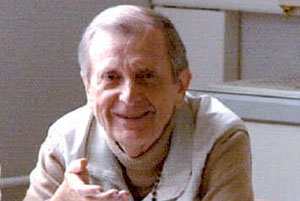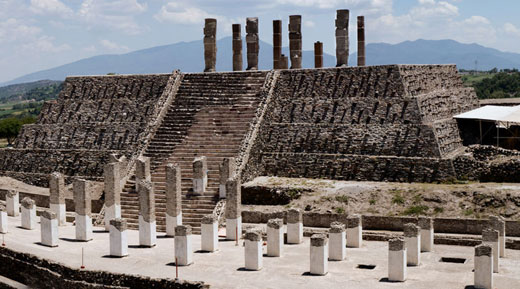by Stanley Krippner, Ph.D. The etymology of the English language word “religion” comes from a Latin verb meaning “to bind together.” The word “yoga” originates from a similar concept, namely “to yoke the human and the divine.”  So when we discuss religion, we are referring to a group of people pursuing a connection with divinity, however the group might conceptualize that term. When we think about the future of religion, we are assuming that religious institutions and ideas are capable of change, even though many of them insist that they are the recipients of a final revelation. However, students of religion from Hans Kung to Huston Smith have emphasized the transformations that have been a part of religious traditions over the centuries. When predicting the future of religion in the 1970s, scholars foresaw more secularization, the decline of religious institutions, and the explosion of “cults” and “sects.” They were partially right and partially wrong.
So when we discuss religion, we are referring to a group of people pursuing a connection with divinity, however the group might conceptualize that term. When we think about the future of religion, we are assuming that religious institutions and ideas are capable of change, even though many of them insist that they are the recipients of a final revelation. However, students of religion from Hans Kung to Huston Smith have emphasized the transformations that have been a part of religious traditions over the centuries. When predicting the future of religion in the 1970s, scholars foresaw more secularization, the decline of religious institutions, and the explosion of “cults” and “sects.” They were partially right and partially wrong.
For example, a number of “new religions” have appeared, including those using ayahuasca as a sacrament; whether they should be called “sects” or “cults” depends upon who is in charge of the labeling process. Paradoxically, the world has become more secular, and church attendance has declined in many countries. On the other hand, conservative churches have grown in membership, and some of the most prominent players on the global scene are evangelical Protestants, conventional Catholics, Hasidic Jews, Tibetan Buddhists, Hindu nationalists, and Islamic fundamentalists. An organization, the World Network of Religious Futurists has been established to track these developments, many of which are impacting the world in ways that were unforeseen by students of religion in the 1970s.
When discussing religious and spiritual issues, I have found it useful to distinguish the two terms. For me, the word “religious” refers to the adherence to an organized system of beliefs about the divine (something deemed worthy of veneration and worship) and the observance of rituals, rites, and requirements of that belief system. “Spirituality,” on the other hand, can be thought of as one’s focus on, and/or reverence, openness, and connectedness to some process or entity believed to be beyond one’s full understanding and/or individual existence. Any rituals, behaviors, or beliefs that accompany this process are internally generated rather than reflective of an external authority or institution.
Albert Hofmann (2005) lamented that “a very deep problem of our time is that we no longer have a spiritual basis in our lives. The churches are no longer convincing with their dogma. Yet people need a deep spiritual foundation for their lives” (p. 50). In other words, Hofmann also differentiates spirituality from religion. He continued, “In the past, this [spiritual] foundation was built on accepted religious creeds, which people believed in. But today such beliefs have less power. We can not believe things that we know are not possible, that are not real. We must go on the basis of that which we know—that which everyone can experience. On this basis, we must find the entrance to the spiritual world” (p. 50). Some people claim to have found this entrance by means of LSD-type substances, sometimes referred to as “entheogens.” I use the term “potential entheogen” instead of “entheogen” because there is no assurance that ingesting LSD, peyote, or mind-altering mushrooms will bring about a spiritual experience “bringing forth the God within,” as the term implies. The variables of set and setting are more complex than the substance itself, and to label these substances “entheogens” simply posits a promise that is rarely delivered.
The Network of Spiritual Progressives challenges the idea that the Christian Right is the only segment of the United States with a concerned interest in moral values as they apply to society. According to its organizer, Rabbi Michael Lerner, in great numbers Americans are experiencing spiritual crises stemming from the practical imperative faced by those in the modern workplace: to put profit and power above everything else. This leaves love, compassion, and a sense of meaning a distant second, evoking suffering and spiritual pain (Catalfo, 2005). But as Albert Hofmann (2005) observed, “Not all young people are looking for money and power. Some are looking for happiness and satisfaction born of the spiritual world” (p. 50).
However, this search for spirit can be co-opted by religious groups that divide rather than unite people. Considerable attention has been given to the Muslim terrorists who embark on jihads against infidels, including those Muslims whose beliefs differ from theirs. In addition, most of the forty ongoing wars in the world are religious as well as political and territorial wars, ranging from Chechnya and Kashmir to Sri Lanka and Sudan. But the Religious Right in the United States also has used divisive tactics in their attempt to capitalize on spiritual pain and use it for their own purposes. Either overtly or covertly, the Religious Right has identified several types of “despised others” such as people of color, immigrants, gays, Jews, and Muslims, as the sources of pain. Relieved to having their deep-seated pain acknowledged and concerned with the moral ground upon which they were raising their families, many Americans have gravitated to this message and to the extremist political agenda of the Religious Right. However, that agenda conflicts with the middle class’s own economic self-interest as well as the fundamental ethical precepts of the great religious traditions, such as healing the sick, comforting the afflicted, sheltering the homeless, and celebrating the interconnectedness of all life.
The Religious Right has been remarkably successful because there was no other game in town. However, every major progressive movement in American history was driven by religious values: abolition of slavery, women’s suffrage, child labor laws, civil rights, etc. (Catalfo, 2005). The Network of Spiritual Progressives is one of several groups in the United States that refuses to allow the Religious Right to claim hegemony regarding spiritual issues. Another group, the Interfaith Alliance, is a cohort of progressive members of the clergy and religious practitioners who work to implement a dynamic agenda that reflects the moral and ethical values needed in the 21st century. The
Center for Sexuality and Religion is also an interfaith group, one that attempts to provide a moral and ethical basis for sexual practices, but seeks an orientation that reflects scientific data, humanistic values, and human diversity. Integrative Spirituality describes itself as an online spiritual consciousness community that enables people to share their transformational experiences, to find and communicate with “spirit mates,” and to participate in surveys about spirituality. It is associated with the Institute of Noetic Sciences and has a data base of 40,000 pages of wisdom from various spiritual traditions.
Religious and spiritual experiences appear to have been hard-wired into humanity’s genetic legacy, suggesting that they played an adaptive role during human evolution. Religion, for example, fosters group discipline and could have given hunter-gatherers an advantage for survival as they grouped together both for worship and for defense against their enemies. Spiritual experiences have been investigated by Andrew Newberg and Eugene d’Aquili (2001) who studied both Buddhist meditators and Franciscan nuns. Using single photon emission computed tomography (SPECT), they found that (when compared to the baseline waking record) specific regions of their participants’ brains showed increased blood flow, while other regions showed marked decreases during their experiential reports. It is not unreasonable to suggest that these meditators and nuns permanently altered their brains in such a way to predispose themselves to spiritual experiences through a neurological process referred to as “kindling.” On the other hand, it is possible to have a spiritual experience without the practice of contemplation or prayer. The neuroscientist Michael Persinger (1987), another researcher in this field, suggested that spiritual experiences can be evoked spontaneously and unexpectedly by mind-altering plants, unusual diets, grief, fatigue, sensory deprivation, sensory over-stimulation (e.g., piercing music) and various personal dilemmas and stressors, all of which seem to be associated with the brain’s temporal lobe lability.
For Newberg and d’Aquili, all spiritual and religious experiences share several characteristics: a progressive increase of unity over diversity, a progressive sense of transcendence or otherworldliness, progressive incorporation of an “observing Self” in the experience, and a progressive increase of certainty in the objective existence of what was experienced in the state (p. 243). This body of research is sometimes referred to as “neurotheology.” However, I think this term is a misnomer. “Theology” is properly defined as the methodological study of the nature and properties of alleged deities (or of a single deity). Cognitive and affective neuroscience have not provided, and have not attempted to provide, this type of knowledge. The studies just cited have focused on peoples’ experiential reports, the psychoneurological correlates of these reports, the way these reports can be categorized, and the manner in which these experiences might be evoked (through contemplation, plants, electrical stimulation, and the like). No claim can be made that these correlates indicate causation; it would be both reductionistic and premature to claim that brain activity “causes” a spiritual experience. The question can be asked, “Is a naturally-occurring spiritual experience more valid than an induced experience?” However, such a question assumes that the “validity” of “naturally-occurring” spiritual experiences has been established. However, investigators have not even agreed on the questions that would need to be asked to establish such validity.
On the other hand, there are enough data available to investigate the application of these findings. Evoked spiritual experiences could address existential issues such as finding meaning in life. A review of one’s spiritual experiences could provide a means of establishing one’s “personal mythology” or “personal theology.” In addition, spiritual experiences evoked by LSD-type substances (see Pahnke, 1966) have been utilized therapeutically with terminal cancer patients, with combat veterans suffering from post-traumatic stress disorder, and with alcoholics and drug addicts.
In the meantime, if religious and spiritual experiences are part of humanity’s genetic heritage, both social scientists and philosophers need to realize that “God won’t go away,” to use the title of Newberg and d’Aquili’s book. The philosopher Cornell West (2002) has argued for a combination of Christian and Marxist perspectives for a “revolutionary Christianity.” West’s writings have been seminal in helping me formulate my suggestions for the ideal religion of the future, a religion (or consortium of religions) that needs to incorporate at least four elements.
These religions needs to be transcendental, acknowledging the existence of some process or entity worthy of respect and reverence, whether it is named God, the Goddess, the Eternal Tao, the Ground of Being, or something else. As Albert Hofmann remarked, “The material world is only the manifestation of the spiritual world”; the so-called “perennial philosophy” that can be found in all religions suggests that the discovery of the spiritual world impacts and changes people’s behavior and attitudes in positive ways, and that this transformation is both profound and long-lasting. Long before the development of contemporary religions, indigenous cultural groups had developed a repertoire of plants, chants, rhythmic music and movement, self-regulatory practices, and voluntary shifts in attentional states to produce spiritual and religious experiences. The case can be made that religion was more experiential in those groups than in contemporary societies, and that peoples’ contact with transcendent realms was more frequent than it has been in modern times. As Hofmann has observed, “Young people are looking for meaningful experiences…, for [something] that is the opposite of the material world.”
Secondly, the religions of the future need to be embodied; they need to accept and cultivate bodily health, sensual pleasure, and sexual diversity. Religious institutions have a centuries-old record of sexism, homophobia, and rage against the body. This is a legacy in need of radical change if religious institutions are to be viable in a world suffering from an AIDS pandemic, as well as child abuse, wife battering, the murder of one’s own family members in the name of “honor,” and the persecution of gays, lesbians, bisexuals, and transgendered individuals. Insofar as AIDS prevention is concerned, most of those representing organized religion have been part of the problem. Too many churches, temples, and mosques either refuse to disseminate information about life-saving sexual practices, or spread information that is distorted, biased, or falsified. Regarding the role of women, mainstream religion has a record of opposition to their participation in church governance and leadership, and has even denied their right to control their own bodies. Although contemporary religions did not initiate the practice of cliterectomy, they have been slow in opposing this mutilation of a vital female organ. Not only have most mainstream religions condemned a woman’s right to abortion, but family planning, birth control, and even feminine hygiene have been discouraged or forbidden.
Although some traditions advocate celibacy as a route to higher consciousness, other traditions see sexual activity as a venerable vehicle for attaining mystical insights. Jenny Wade (2004), a transpersonal psychologist, interviewed nearly 100 people with various sexual orientations and from several religious backgrounds, constructing a typology of mystical, spiritual, or transcendent experiences during sex. Her typology was based on a model developed by the psychiatrist Stanislav Grof (1998) who analyzed reports from thousands of clients participating in LSD-facilitated psychotherapy and/or so-called “holotropic breathwork.” Wade reported that her research participants’ transcendent experiences resembled those of Grof’s group, especially in such areas as “ecstatic union” and the movement of “kundalini energy.” Indeed, Newberg and d’Aquili (2001) posited that romantic love, as characterized by the phrase, “It’s bigger than both of us,” may be a transitional phase between aesthetic and religious experience, a signpost on the way to a state they call “absolute unitary being,” a state in which the boundaries of entities within the world disappear and the self-other dichotomy is obliterated. It is equated with the “void,” with “nirvana,” and/or “the experience of God” (p. 236).
The third hallmark of future religions is that they need to be socially relevant and liberating, opposing tyranny and social injustice. Religions of the future need to afford opportunities for sharing, compassion, peacemaking, and the manifestation of love. This love should be extended to the natural environment, a resource that is threatened by global warming, pollution, desertification, and the destruction of the rain forests. Albert Hofmann has advised people “to go out into the countryside” because “such places are of the world of nature, to which we fundamentally belong. It is the circle of life, of which we are an integral part.” But the meadows and woods extolled by Hofmann are being threatened by human insensitivity and greed. This misuse of technology, as Hofmann has reminded us, “could not have emerged from a consciousness of reality in which human beings are not separated from the environment but rather exist as part of living nature.”
Finally, the religions of the future needs to work with science and not in opposition to the scientific method, scientifically gathered data, and scientifically conceived theories. Science and religion ask different questions; science inquires as to “how?” while religion queries “why?” So-called “scientific creationism” is an oxymoron, one that is dogmatic rather than scientific and that denies the beauty of Darwinian Theory as well as its remaining mysteries. Albert Hofmann adds that “We are at a phase of human development where we have accumulated an enormous amount of knowledge through scientific research in the material world. This is important knowledge, but it must be integrated.” For Hofmann, “the different forms of religion are no longer adequate. They are simply words, words, words, without the direct experience of what it is the words represent.” But science that is not integrated into our lives can end up simply as “words, words, words” as well. Future religions can assist people to extract meaning from scientific data, balancing what Hofmann calls “these two sides of our lives.”
In other words, the new religions will be a dramatic contrast to the old religions that insist that an idea is either true and revealed or false and heretical. Science has always been an incomplete project; outmoded theories are replaced by new data and novel hypotheses are put forward in attempts to explain fresh discoveries. The religions of the future also need to admit that they are incomplete processes, but represent a quest that is necessary to inspire and provide consolation for the human species, especially during times when inspiration and hope are rare commodities.
What role will LSD-like substances play in the religions of the future? Peyote, mushrooms, and ayahuasca are currently utilized as sacraments in both old and new religious institutions. However, Albert Hofmann reminds us that “it is quite possible to have [spiritual] experiences without drugs.” With or without the use of LSD-type substances, religions that are both transcendent and embodied, both socially conscious and scientifically informed, have the potential to help mend the torn cultures that already devastate the landscape of this new century.









































